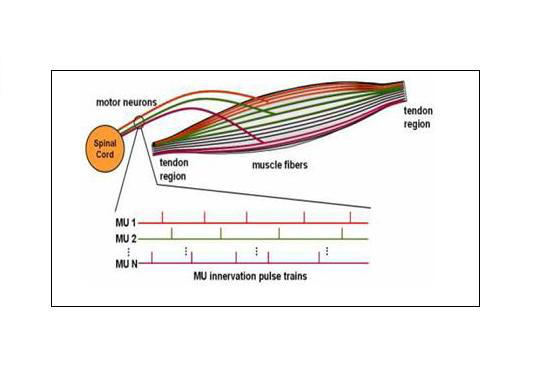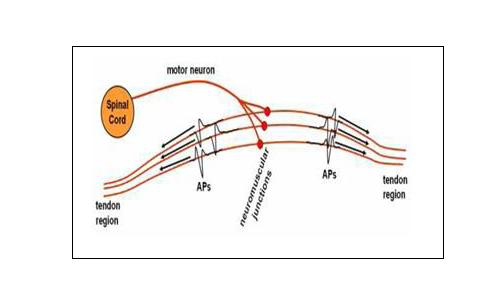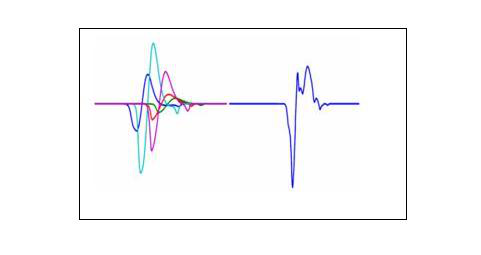To simulate Electromyogram Signal
Theory
Electromyography (EMG) is a technique for evaluating and recording the electrical activity produced by skeletal muscles. EMG is performed using an instrument called an electromyograph, to produce a record called an electromyogram. An electromyograph detects the electrical potential generated by muscle cells when these cells are electrically or neurologically activated. The signals can be analyzed to detect medical abnormalities, activation level, recruitment order or to analyze the biomechanics of human or animal movement.
There are two kinds of EMG in widespread use:
- Intramuscular EMG: It is measured by a needle electrode or a needle containing two fine-wire electrodes is inserted through the skin into the muscle tissue.
- Surface EMG (sEMG): It is the recording of the muscle's electrical activity from the surface of the skin. In clinical application, sEMG is used for the diagnosis of neuro-muscular disorder and for rehabilitation. It is also used for device control applications where the signal is used for controlling devices such as prosthetic devices, robots, and human-machine interface. The advantage of sEMG is due to its non-invasive recording technique and it provides a safe and easy recording method. The underlying mechanism of sEMG is very complex because there are number of factors such as neuron discharge rates, motor unit recruitment and the anatomy of the muscles and surrounding tissues that contribute to the recording.
Generation of sEMG:
sEMG signal is generated by the electrical activity of the muscle fibers active during a contraction. The signal sources located at the depolarized zones of the muscle fibers are separated from the recording electrodes by biological tissues, which act as spatial low-pass filters on the (spatial) potential distribution. It is closely related to the muscle activity, muscle size and a measure of the functional state of muscle fibres. This section presents a brief explanation about the anatomy, physiology and the electrical properties of the muscle and the composition of sEMG.
Physiology of human muscular system:
The physiology of the human muscular system has been explained as follows: Structure of muscle: A muscle consists of a large number of muscle fibers that are grouped into several motor units. A motor unit is the basic level of the neuron motor system of the muscle. A motor unit (MU) consists of an a - motoneuron in the spinal cord and the muscle fibers it innervates. All the muscle fibers in a motor unit are controlled by a single motor neuron. The number of MUs per muscle in humans may range from about 100 for a small hand muscle to 1000 or more for large limb muscles. The number of muscle fiber per motor unit in a muscle is called the innervations ratio. The muscles of the face that execute a precise movement have the highest level of innervations ratio (3 muscle fibers per motor unit). The muscles that produce a large amount of force have lower innervations ratio. Each muscle fiber in a motor unit is connected to each axon branch of the associated motor neuron at a point called neuromuscular junction (NMJ). The neuromuscular junction is located in a region in the middle of the muscle length called the innervations region. This is shown in Fig 1.

Muscle Contraction: Muscle contraction is a result of the stimulations from motor neurons. Voluntary muscle contraction is used to move the body and can be finely controlled, such as movements of the finger or gross movements that of the biceps and triceps. There are three types of muscle contractions.
- Isometric Contraction: In isometric contraction, the muscle is contracted while the length of the muscle is unchanged. These contractions are used in the postural control.
- Concentric contraction: Concentric contraction occurs when the length of the muscle shorten during the contraction. The amount of the available muscular energy in concentric contraction is less than the isometric contraction due to the energy loss related to the shortening of the muscle. Concentric contraction occurs when the length of the muscle shorten during the contraction. The amount of the available muscular energy in concentric contraction is less than the isometric contraction due to the energy loss related to the shortening of the muscle.
- Eccentric Contraction: Eccentric contraction occurs when the length of the muscle increases during the contraction. The concentric and eccentric contractions are also known as un-isometric contraction.
Recruitment Pattern: The process of selecting which motor units to be involved in a muscle contraction is called the recruitment process. The current understanding of the motor unit recruitment pattern in a muscle is based on the size principle. It demonstrated that motor units are always recruited in order of increasing size of the a- motoneuron. For a small level of contraction, the motor units with small number of muscle fibers are recruited. As the contraction level increases, the larger motor units are involved in the contraction. In an isotonic contraction which produces a constant force, the activation pattern switches from one motor unit to the other to avoid the fatigueness of a motor unit.
Motor Unit Action Potential (MUAP): A motor neuron activates its motor unit by stimulating the motor unit's muscle fibers with the nerve action potential (AP) that travels along the axon towards the muscle fibers. The electric impulse that is propagated along the motoneuron arrives at its terminal and causes the emission of acetylcholine (ACh- a chemical substance) in the gap between the nerve terminal and the muscle fiber membrane, which excites the fiber membrane at this neuromuscular junction. In this case a potential gradient in a part of the fiber is generated. It creates the depolarization zones on the muscle fibers that propagate away from the NMJ point in both directions towards the tendon (end point) of the muscle fiber. The depolarization occurs due to the sudden increase of the membrane permeability to sodium (Na+) which results in a sudden influx of sodium into the muscle fiber. The process changes the resting potential of the fiber's cell to a level of electrical potential called action potential (AP). In general, the action potential can be characterized by a depolarization phase, a repolarization phase, and a hyperpolarizing long after potential. The AP shape may change due to the conditions of the muscle and few stages of AP alteration can be distinguished during fatigue. In the beginning of fatigue, the AP spike width in space increases mainly because of the slowing of the repolarization phase. In this phase the rate of increase of the AP remains practically unchanged while the amplitude decreases slightly. The representation of the action potentials generated by the motor unit's fibers is shown in Fig.2. The generation of the action potential creates an electric field in the surrounding space.

Hence, the potential generated by motor unit can also be detected in locations relatively far from the source. The biological tissues separating sources and the detecting electrodes are referred to as volume conductor and their characteristics strongly affect the detected signal. The shape of the MUAP is affected by the geometrical arrangement of the muscle fibers, the electrode proximity and the properties of the body tissues between the muscle fibers and the recording site. MUAPs recorded with indwelling electrodes may have amplitude in the millivolt (mV) range, while the magnitude of the action potentials recorded with surface electrodes is of the order of microvolts (μV). Fig.3 illustrates the superimposition of the MUAPs those results in the generation of sEMG. Motor units must be activated repeatedly to sustain the force created by a muscle during a contraction. The frequency of the stimulation of a motor unit is called the firing rate of the motor unit. The firing rate determines the level of contraction and the type of muscle fibers. At the start of a contraction, a motor unit is fired irregularly at a rate of about 5-7 Hz.

As the level of contraction increases, the motor neuron increases the firing rate to higher frequency. As the firing rate reaches 10 Hz, the second motor unit is recruited into the contraction while the firing rate of the first motor unit increases to a certain level according to the type of muscle fiber in the motor unit. In general, there are two categories of muscle fibers based on the speed of the firing rate. A slow twitch muscle fiber has a firing rate of about 10 to 20 Hz, while a fast twitch muscle fiber has 30 to 50 Hz firing rate.
